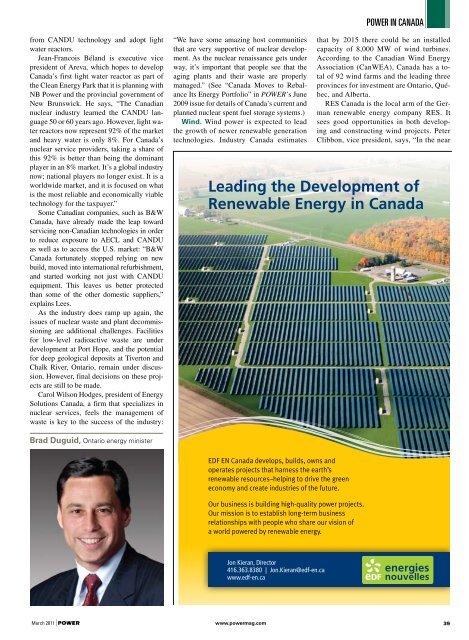Canada: A Green Energy Superpower - GBR
Canada: A Green Energy Superpower - GBR
Canada: A Green Energy Superpower - GBR
Create successful ePaper yourself
Turn your PDF publications into a flip-book with our unique Google optimized e-Paper software.
from CANDU technology and adopt light<br />
water reactors.<br />
Jean-Francois Béland is executive vice<br />
president of Areva, which hopes to develop<br />
<strong>Canada</strong>’s first light water reactor as part of<br />
the Clean <strong>Energy</strong> Park that it is planning with<br />
NB Power and the provincial government of<br />
New Brunswick. He says, “The Canadian<br />
nuclear industry learned the CANDU language<br />
50 or 60 years ago. However, light water<br />
reactors now represent 92% of the market<br />
and heavy water is only 8%. For <strong>Canada</strong>’s<br />
nuclear service providers, taking a share of<br />
this 92% is better than being the dominant<br />
player in an 8% market. It’s a global industry<br />
now; national players no longer exist. It is a<br />
worldwide market, and it is focused on what<br />
is the most reliable and economically viable<br />
technology for the taxpayer.”<br />
Some Canadian companies, such as B&W<br />
<strong>Canada</strong>, have already made the leap toward<br />
servicing non-Canadian technologies in order<br />
to reduce exposure to AECL and CANDU<br />
as well as to access the U.S. market: “B&W<br />
<strong>Canada</strong> fortunately stopped relying on new<br />
build, moved into international refurbishment,<br />
and started working not just with CANDU<br />
equipment. This leaves us better protected<br />
than some of the other domestic suppliers,”<br />
explains Lees.<br />
As the industry does ramp up again, the<br />
issues of nuclear waste and plant decommissioning<br />
are additional challenges. Facilities<br />
for low-level radioactive waste are under<br />
development at Port Hope, and the potential<br />
for deep geological deposits at Tiverton and<br />
Chalk River, Ontario, remain under discussion.<br />
However, final decisions on these projects<br />
are still to be made.<br />
Carol Wilson Hodges, president of <strong>Energy</strong><br />
Solutions <strong>Canada</strong>, a firm that specializes in<br />
nuclear services, feels the management of<br />
waste is key to the success of the industry:<br />
“We have some amazing host communities<br />
that are very supportive of nuclear development.<br />
As the nuclear renaissance gets under<br />
way, it’s important that people see that the<br />
aging plants and their waste are properly<br />
managed.” (See “<strong>Canada</strong> Moves to Rebalance<br />
Its <strong>Energy</strong> Portfolio” in POWER’s June<br />
2009 issue for details of <strong>Canada</strong>’s current and<br />
planned nuclear spent fuel storage systems.)<br />
Wind. Wind power is expected to lead<br />
the growth of newer renewable generation<br />
technologies. Industry <strong>Canada</strong> estimates<br />
power in canada<br />
that by 2015 there could be an installed<br />
capacity of 8,000 MW of wind turbines.<br />
According to the Canadian Wind <strong>Energy</strong><br />
Association (CanWEA), <strong>Canada</strong> has a total<br />
of 92 wind farms and the leading three<br />
provinces for investment are Ontario, Québec,<br />
and Alberta.<br />
RES <strong>Canada</strong> is the local arm of the German<br />
renewable energy company RES. It<br />
sees good opportunities in both developing<br />
and constructing wind projects. Peter<br />
Clibbon, vice president, says, “In the near<br />
Brad Duguid, Ontario energy minister<br />
March 2011 | POWER www.powermag.com 39

















